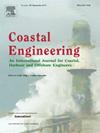Quantifying compound coastal flooding effects in urban regions using a tightly coupled 1D–2D model explicitly resolving flood defense infrastructure
IF 4.2
2区 工程技术
Q1 ENGINEERING, CIVIL
引用次数: 0
Abstract
Low-lying coastal areas are highly vulnerable to flooding hazards. High marine water levels may overflow seawalls, render the storm drain system inoperable, and promote pluvial and wave overtopping flooding. Complex interactions between various coastal flooding drivers (marine water levels, precipitation, waves) and urban infrastructure (i.e., the stormwater system, and seawalls) are characterized using a novel, tightly coupled hydrodynamic model. Flood extent field observations of tidal overflow, pluvial flooding, and overtopping flooding, along with storm drain system pressure sensor data are used to evaluate hydrodynamic model performance. High marine water levels, precipitation, and overtopping events are modeled and compared with validation data. Results suggest the hydrodynamic model explicitly resolving both 1D storm drain pipe flow and 2D overland flooding more accurately simulates compound flooding compared to typical 2D overland flow models. Nonlinear compound effects were resolved by comparing combined univariate flood impact to corresponding compound flood impact modeled within a tightly coupled 1D2D infrastructure-resolving model. Projected flood extents were 50% greater when compound interactions were resolved. Compound effects vary with event type, event magnitude, and site characteristics. Critically, coastal adaptation strategies protecting against high embayment water levels such as elevating seawalls may exacerbate compound flooding effects in low-lying communities.
使用紧密耦合的一维-二维模型明确解决防洪基础设施,量化城市地区的复合沿海洪水效应
低洼的沿海地区极易受到洪水灾害的影响。较高的海水水位可能会溢出海堤,使雨水渠系统无法运作,并导致洪水和波浪泛滥。利用一种新颖的、紧密耦合的水动力模型,描述了各种沿海洪水驱动因素(海平面、降水、波浪)和城市基础设施(即雨水系统和海堤)之间复杂的相互作用。利用潮汐溢流、雨洪和过顶洪水的洪水范围现场观测数据,以及雨水排水系统压力传感器数据来评估水动力模型的性能。模拟了高海平面、降水和过顶事件,并与验证数据进行了比较。结果表明,与典型的二维坡面流模型相比,该水动力模型能更准确地模拟复合洪水,同时解决了一维暴雨排水管流和二维坡面洪泛问题。通过将单变量洪水影响与紧耦合1D2D基础设施解析模型中相应的复合洪水影响进行比较,解决了非线性复合效应。当复合相互作用得到解决时,预测的洪水范围增加了约50%。复合效应因事件类型、事件震级和场地特征而异。至关重要的是,提高海堤等抵御高堤坝水位的沿海适应策略可能会加剧低洼社区的复合洪水效应。
本文章由计算机程序翻译,如有差异,请以英文原文为准。
求助全文
约1分钟内获得全文
求助全文
来源期刊

Coastal Engineering
工程技术-工程:大洋
CiteScore
9.20
自引率
13.60%
发文量
0
审稿时长
3.5 months
期刊介绍:
Coastal Engineering is an international medium for coastal engineers and scientists. Combining practical applications with modern technological and scientific approaches, such as mathematical and numerical modelling, laboratory and field observations and experiments, it publishes fundamental studies as well as case studies on the following aspects of coastal, harbour and offshore engineering: waves, currents and sediment transport; coastal, estuarine and offshore morphology; technical and functional design of coastal and harbour structures; morphological and environmental impact of coastal, harbour and offshore structures.
 求助内容:
求助内容: 应助结果提醒方式:
应助结果提醒方式:


